It's the end of the world
"..as we know it.." This trip has reached (and passed) its southernmost stop, in the words of REM. We spent our Juhannus in Torres del Paine, a big national park in southern Chile and probably THE trekking/hiking/camping place in the country. Sorry you all who called with drunken/happy messages from the midsummer parties, I could not listen to any of the voice messages. I'm sure they were lovely, thanks.
In Torres del Paine we first saw the caves of the Milodon, a prehistoric creature whose remains were found in the cave. The big fellow looked like this:

The real sights of Torres del Paine were of course all the scenery. Here you have one postcard shot of the mountain range (which is in fact the heart of the national park) and within it the actual three towers (
torres). The other one is of the first part of the Patagonian glacier we saw, the Glaciar Grey (pieces of it in the front and the big mass itself barely visible in the distance).


Travelling to and from the
Fin del Mundo itself, Tierra del Fuego, was not all that easy. Here I'm freezing on the crossing of the Magellan strait:

The southernmost destination on the whole trip was none the less than the southernmost city in the world, Ushuaia, on the Argentinian side. As we got there, the people were celebrating in the centre as Argentina had just won Mexico in the World cup. I kept my Mexico-sweater well hidden at that time -and in anticipation of the upcoming fall of the Germans we both bought Argentinian football shirts..

In Ushuaia we first got acquainted (again) to the Argentinian food culture (now I'm officially in heaven with all the eat-all-you can meat around) and had our share of the party. The next day was spent chilling and walking in knee-deep snow (without snow shoes, of course, but why should crazy Finns care) in the Tierra del Fuego national park. This was the first time the clothes really were not adequate for the place where we were..


To the upset of all you skiing mainiacs, we also went for some snowboarding in the southernmost slopes in the world, Cerro Castor right there in Tierra del Fuego. It was rather cold at first, but the scenery just took ones breath away. And though some slopes were still closed, the majority was still in good enough shape. On top (or bottom?) of the world, mom:

Our visit to Ushuaia was completed with a boat tour in the Beagle channel, where we saw, among other things, an island full of sea lions (too bad, no penguins here this time of year..).

Our next stop was El Calafate, some 18 bus-hours north of Ushuaia. There we took a peak of one of the most active ice fields in the world, the Glaciar Moreno. I could not fit the whole chunk in one picture, as it is 5 kilometers wide in the front and 14 km long (you'd think looking at the photo below that the mountains in the back are closer than 14 km away, wouldn't you?). The front of it is "just" some 60 meters high and it moves some 40 cm per day, breaking every now and then. Being there you can hear the ice crack and sometimes see the pieces falling into the lake. You are left in awe and I myself with a huge urge to go to the Antarctic some day..

On a different note, being here (both Chile and Argentina) has really opened my eyes to the machismo and the general male attitudes here.. Maybe it is just the jealous me talking, but I feel like having some words with some of the drooling guys around. Or then again, maybe It's not just me: a father of two was taking pictures of Johanna in the supermarket with a camera phone -while carrying his daughter! All while talking to the girl: "look how beautiful she is".. Seriously, what kind of a sick a-hole would do that?!? Maybe I should just feel flattered, but some guys really go too far.
All in all, this has been one of the best things (if not THE best) ever! I've kept the schedule tight as I usually do, but Johanna has been great about it and we have really enjoyed the trip even while seeing lots of stuff. Now the next thing is the anxiously expected Buenos Aires, a place of which everybody I meet spills nothing but exceptional reports. And besides, Simo owes me one -or two. ;)
To seal this entry, here are the basic things about Chile: Bic Mac Meal is 2100 pesos (3,05 euros) and the lonely burger 1550 pesos (2,25 euros). The specialty of McD's there is the quarter pounder with avocado.. Also, I did pass all my courses!! The better-quality-than-HSE -formula did not apply in giving the grades, obviously, but I'm just glad to have no problems back home then. In regards to the thesis, I might have some interesting news by the next entry, but can't promise a thing quite yet..
Best national beer tasted: Escudo. Extensive tasting. Second only to Tecate in the world (so far).
Best national dish: Churrasco italiano (a hamburger-like fast food with mayo, avocado and tomato). So shoot me who does not agree.
Best sight/experience is just way too hard to decide.
Midsummer around zero degrees
Yeah, that is the deal for me this year. We just arrived to snowy Puerto Natales from Puerto Montt on a 3-day ferry ride. It was an experience indeed.. The sea-stomach trained by the Finnish marines and numerous adventures around Tallinn and Stockholm boats was given a ride for the money on the less gentle waves of the Pacific. Let us just say that the movie Perfect Storm was made reality in front of my eyes with some 30-foot waves rocking the boat.. I did do better than Johanna who had to really fight it, but all in all my respect for the crazy dudes sailing the Magellan strait and up the Chilean coast hundreds of years ago just went up a couple hundred percent or so. Here are some happy sailors before the open seas (it was not actually even a storm..) and the Navimag "cruiser":


Have a nice Juhannus y'all, I know we will be enjoying it hiking in one of the most famous national parks in Chile, the Torres del Paine, before heading even further south. Keeping the fingers crossed that our "winter" clothes can keep us warm once we hit the end of the world..
Adventurous Pusko
Taking off from Santiago was not as easy as I had anticipated, but also the excitement of the upcoming travels were a good motivation to get everything organized, send a package to Finland and say goodbye to the rest of the people.
From Santiago we took off to Pucòn (or Pusko, as "one" co-traveller thought the name to be at first), a small city some 500+ kilometers south of Santiago near the Argentinian border. It is the place in Chile to do it all when adventure travel and experiences are concerned. I was a bit worried that we might be wasting our time there, as I had heard the weather had been terrible there for a while. However, when we arrived, the sky was totally cloudless.
First we took a tour of local sights and then made sure we had ourselves booked on the climb on top of a 2900-meter volcano (Volcan Villarrica) for the next day. We were in luck indeed, as we later heard that in June 2005 only one day was good enough for climbing the volcano. Here are some pics from the first day (in the last one you see the volcano):



Climbing the volcano was a bit strenuous, but not as much as I had thought. It was a bit dangerous though with the possibly extreme weather conditions and the fact that the volcano is in fact active (pool of hot magma in the crater all the time). The steep price did include all the necessary equipment and insurances, plus expert guides.
The climb started early in the day to have a chance to get there and back before dark. At no point were we guaranteed to reach top, but again we had luck and were blessed with clear weather (even climbing in a t-shirt at times) until the 5,5 hour climb was done. I did not even care that that day the volcano was spewing out so much vapor (last photo below) we could not see the magma in the crater. I guess you cannot win all the time, huh? Especially as coming down went fast due to clouds gathering behind us on the top (by the time we were down again you could not even see the volcano anymore -and the next day the weather was terrible all day) and thanks to the guides that led everybody down the slopes on our asses, a little childish fun to seal the deal.







On our last day in Pucon wew still went to bathe in the hot springs before we headed to the happy couples' capìtal of the world, Puerto Montt (look closely at the statues in the picture). From here we will take a 4-day ferry to Puerto Natales, luckily already tomorrow.. To see the female thinking about this trip, go see Johanna's blog (link on the left).


Happy days
Finally, Johanna arrived to Chile. Four months can seem like a lifetime, but good things are worth waiting. I decided to forget my student status for a while and celebrate a few days as if I had the lifestyle I hopefully will some day. Those good (and warm, a novelty in Chile) hotel nights and dinners at restaurants left a bit different picture of Chile in my mind after all.
Getting good at it, I took Johanna for what is referred to "the Stenbäck tour" of Santiago and its surroundings. Here are some shots from it, trying to avoid repeating myself:





Sunset in the smoggy Santiago at night, some student protest messages (I bet all you KY guys get a kick out of this) in a local school, then a good-bye -shot from Cerro Santa Lucia (in the dead centre of Santiago, and no, we did not agree to wear the same color shirts..), some pelicans on our suite balcony in Viña del Mar and finally, the "devil" that is said to haunt the wine cellars of Casillero del Diablo (look closely, on the back). BTW, a major Thank You to Sami who finally made me see the light on using Flickr to put the photos here (hence the different look). You can click the photos to see them (and others) in my Flickr site better.
I believe I can fly
"..I believe I can touch the sky.." Yup, did some paragliding in Iquique. On my way back "home" to Santiago I stopped over in this city in the Northern parts of Chile, as it has a geography quite unique (basically, huge sand dunes close to the sea) and especially good for paragliding.
I had to take a tandem jump as there was no time to take a course and quite frankly, the prices were ridiculous. I paid 40 euros for under 30 minutes of flight time, doing it tandem. And, we had to wait for 2 hours for the wind to pick up. I told the instructor not to say I am too heavy for the slow winds so he did not say much in the remainder of the trip. Conclusions are being drawn as we speak.
Ok, the airtime itself was fabulous. We were just floating in the sunny air over the beaches of the city (something this country could use some more again) and landing smoothly on the sand. Still, nothing compared to a good bungee-jump. I was just left with the urge to do a real skydive. Sorry mom, there must be something wrong in my head..
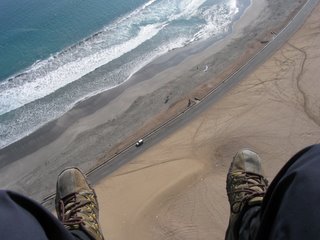
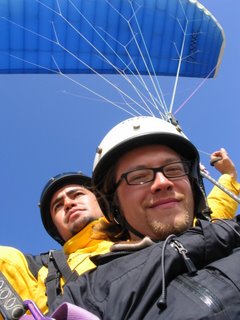
Coming to Santiago was a real no-thank-you. The last five hours of bus moving south towards Santiago was pure rain. The fall is here. I also read from the newspaper, that there are major floods in the place in mid/south Chile where I am supposed to go with Johanna soon. But that is not all - in Santiago a major strike has begun, by the students! They are negotiating with people four times their age for better financial possibilities to study and who knows what else. My "local" school that usually lets out hundreds of annoying teenage "gringo"-shouters on weekdays had today just about every chair of the building thrown into the entrance portcullis with very threatening signs all over the place. Good thing is that the strike came now and not weeks earlier, as I'm not so sure how I could have explained in Finland the courses I did not pass with the phrase "But we were on strike"...
Bye bye Bolivia
So, that chapter of the journey is done. Having enjoyed my bloody trip to La Paz so much I continued straight to Copacabana, on the shores of lake Titicaca (not the famous Cuban city -just yet..). This time the bus took me all the way though I did have my doubts there for a while. Lake Titicaca is a 9,000 sq km "puddle" in the middle of the mountains and in a genuine Bolivian style it is the world's highest navigable lake. Beautiful clear water everywhere, not to mention that on the Bolivian side (it is half Peruvian and half Bolivian) there are significant places for the Inca culture, like the Isla del Sol in the picture below. The Incas believe that the Sun was born there, and also at the Northern end of the Island there is a sacred rock called the Rock of the Puma out of which supposedly the first Inca emperor arose. Too bad that the two Inca colonies on the island were having major disagreements at the time and it was impossible to get to the sacred rock by boat and there was too little time to walk it (total of 6 hours walking) thanks to the ferry timetables. Also, the ferry "forgot" to pick us (me and two locals) up at the agreed time, but we managed to get to the mainland anyway and started a long complaint-process, which ended up at me being paid 85 bolivianos in return of the original 15 I had paid for the trip. So I guess my spanish is starting to be on the '98 level again.. This time the key to winning the argument was that as I was a lawyer, I would bring the police to investigate and all the tour guides would lose their jobs and pay immense compensations out of their puny salaries to me and my fellow passengers.. Lucky they bought the story much better than I did myself. ;)

Here's a shot from the slopes of Isla del Sol. Notice how the sun shines on your face even in the shadow.
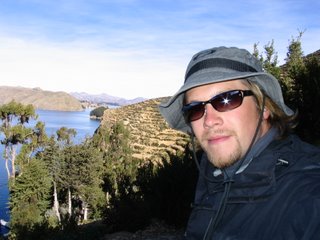
Here below is the town of Copacabana. Also quite touristy, actually surprisingly so as were many places I saw in Bolivia. I spoke more English in two weeks in Bolivia than in three months in Santiago! But anyway, Copacabana was touristy in a nice way, they did not try to scam you out of your money though service was on other level. Well, except for a small boat ride incident. This town also showed a second surprise that the shores of Lake Titicaca presented -this being that Bolivia actually has some beaches. The first surprise was that Bolivia has an Armada (logical, as it has SOOO much coastline) and according to one emblem, at least four divisions in it as well. Impressive. Actually, the debate relating to the coastline is still on in the minds of the Bolivians. Now they transport all their sea-faring goods to Arica (Northern Chile). Chile would have granted them a right for a port in the Pacific, but Bolivian pride could not accept such bits of mercy after getting their asses kicked in the war. But speculation is still a hot topic in the press at least.
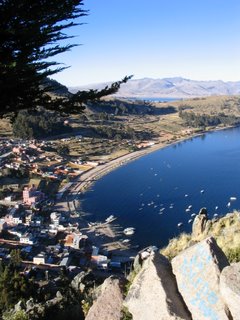
After Copacabana it was time to head to La Paz. The capital is a quite peculiar town with only a bit over 2 million people in it. It is also shaped as a bowl or a stadium, and it is said that it is impossible to get lost there. I beg to differ, as street names are rarely marked and they change every now and then (however, not after every second quarter like in Peru). Talking about street names, Bolivians have really overdone the Latin American trend of naming the streets after significant dates. Either they have loads of these dates or then they used the NON-significant ones. And they even love them so much, that they extended this trend to school names and others, like bus company names. Such use of imagination can rarely be witnessed: You can say that you got the 4th of July's bus in front of 18th of September elementary school and headed down on 6th of December.
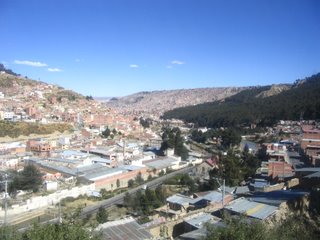
The city of La Paz is guarded by the year-round snowy-peaked mountain Illimani in the background in the photo below (some 6,400 meters high), though the city itself is only at 3,600 meters (still, in genuine Bolivian style it is world's highest.. capital), with a depth of the "stadium" being an impressive 400 meters.
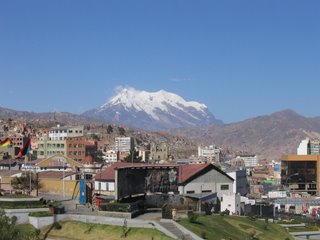
Being true to my blogging habits, I went to search for a McDonald's to get a Bic Mac index number, but just to learn that they had closed the McD's there long ago.. Burger King did fight for existence with its only one surviving restaurant, but that was not of any help. Anyway, the actual reason why McDonald's are not operating there remained unclear, but I'm guessing there are politics involved. Too bad as I'm sure this would have been a price winner (or loser) on the comparison, that cheap is the country. I mean, I had a hard time spending 120 USD on anything even remotely usable in a week (this includes already lodging, 2-3 meals a day and trips totalling to some 35 hours). But the good thing about La Paz is their immense number of street vendors. I'm surprised if any supermarket sells anything there, that much of the vendors were scattered on the streets with different products ranging from plasma-TVs to hair care products and cheesy novels. All in all, Bolivia was an experience to be recommended, but not for everybody.
Best national beer tasted: Paceña centenario
Best national dish: Piqueo Macho (meats and vegetables mixed with strong condiments, local "pyttipannu")
Best sight/experience: Mine tour (the most unforgettable being still the sacrifice of llamas -easily)
Censored!
To you all that already saw the pictures in the last post and liked them, good for you. For those that saw them and didn't like them, I'm sorry. And for those that did not see them, I can arrange that you get to view llamas being killed, skinned and hacked into pieces, I have so many photos that you can cetrainly feel the atmosphere if you want to..
I took the most horrendous ones out since this is an open blog and you never know who enters here. Yes, there is a conscience after all. In addition, websites have been closed for less and I have put too much time and effort into this blog just to see it closed because of some pictures. The original idea was to shock you with the reality here as much as it shocked me, but as you can not get a virtual bloodbath, better just leave a couple photos to give the general idea.
I chickened out -so shoot me. ;)
A man's job
_DISCLAIMER: Viewer discretion: Photos at the end of the post can be shocking, so faint of heart and animal lovers should not go there..._
*EDITED*As promised, here's some enlightenment about mining in Potosí. Mining (at least there) is by far the toughest job I have seen, and not just physically. Now all you überfemisists can wave your fists in the air and rip your skirts, but I was there and I am telling you, that mine is no place for a woman. Actually, it is no place for a man either, but there they are. I know I would not last even a day of that stuff, three hours was already pushing it and I was just observing!
They work at inhuman circumstances, in the heart of the mountain (level 5, some 700 meters underground) it is over 50 degrees and already on the second level (some 250 meters under ground) breathing is difficult and photos taken there show particles in the air. Of course, compared to sea level we are still talking about over 3500 meters.. Though diseases are just the second most common reason for dying (most common being exploding or dying in a cave-in caused by one), it is said that few live over 15 years past the day they start to work in the mines. Most common diseases they die of are respiratory diseases or stomach problems. Back in the glory days of the city they brought African slaves to the mines, but they could not take it and were put to housework instead. Now there are about 400 mines in the area, with some 38 mining companies and over 12,000 miners. One group of workers can produce about 8 tons of minerals per week, so no lazy business there..
I went on a tour that took us to the miners market, a mineral refinery (less impressive) and a mine itself. Probably the most amazing part for me was the market, where we went to buy the miners some gifts as a thanks for having us for a visit. Anybody could just walk in and buy dynamite! Also, second big hit on fridays is pure, potable alcohol (96%) which is the miners' delight (NOT mixed). And third, as the country is Bolivia, Coka leaves. All these and much more stuff were on sale at this market because all the miners pass it on their way to work. And buying any of those things is completely legal! At this point I must add that the Coka leaves are not a drug, they are actually used for everyday tea as well.. So even though I got to "try" all of the above, I will keep off the refined Coka, prefer beer and not begin a career as a terrorist. To explain why miners like that stuff, the dynamite is rather obvious but pure alcohol is preferred as it is best to carry the least amount to the mine and it lasts long and it supposedly even tastes good (get a load of these guys!!). Coka leaves are traditionally chewn (with or without catalysts, but I was told the proper amount is 200-500 leaves at a time!) here to get rid of hunger, tiredness and pain -the miners' main excuse is that they can not bring food to the mine so their luch must be Coka leaves. Here's one happy camper with his purchases -dynamite, pure alcohol and a bag of Coka:
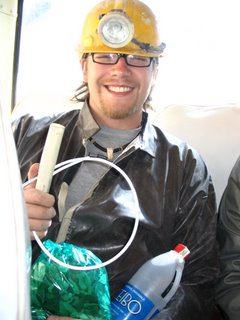
The mine itself was also quite a shocker. The first picture is the happily unaware "before" picture. Then you have me at the fourth level (we did not go deeper, thank God) and finally an "after", a walking corpse again totally unaware of anything and just minutes before the dynamite explosion..
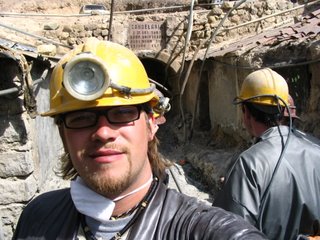
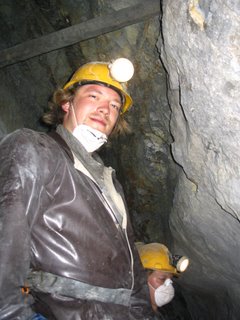
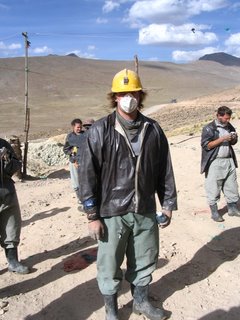
In the mine they revere the tio, the mine god. It has many forms but as Chiristianity tried to get rid of it, it is often depicted as the devil. Tio needs to be living happily with Pachamama, Mother Earth (bfore every drink you must pour some on the ground -or floor- for her), so that the miners are safe and get the riches out of the mine. Pachamama's dealings are next, at the already infamous end of the post. Before that also a picture of men at work on the third level, note the particles in the air.
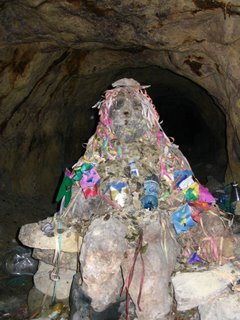
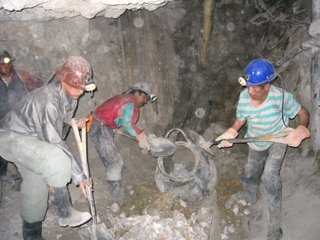
So, I stayed for an extra day in Potosí as there was a big miner celebration in honor of Pahcamama coming up. The deal was, to make a long story short, that the miners had a day off and after a morning of soccer games the groups bought some living llamas from the market and sacrificed them in front of the mine. Heavy alcohol use, explosions and barbecue were also in the picture. So here we go with some gruelsome evidence of the event (EDIT: I took out the most shocking photos, see next post):
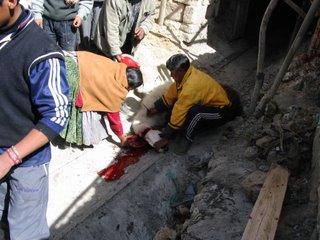
*CENSORED*
*CENSORED*
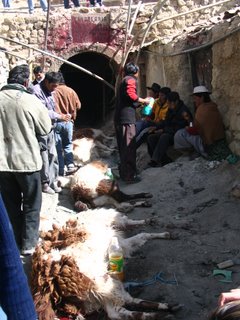
*CENSORED*
*CENSORED*
Blood bowls were thrown everywhere, as the blood blessed their houses etc. -well guess who also got a good load of it? Yep, the right man in the right place, me. I got llama blood all over my side and at that point had no choice but to travel 11 hours in a bus with bloody clothes. Luckily they were black so nobody (hope) noticed. I left the party before the alcohol use got out of hand; when I got on the bus I saw them fixing something with dynamite..
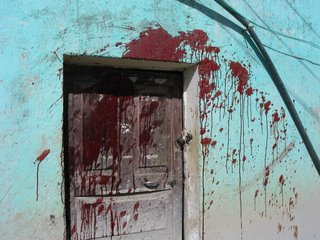
But, in the end, such wonders are going on in the Unesco World Heritage list town, Potosí. Now I invite all the chicks (and guys) who got interested to go join a mining group in Bolivia!
No coast in Bolivia
Had to come and see it myself. Some of you know why this is important to me: it is because I lost a Trivial Pursuit game once in 2003 because the game claimed that the only South American country without a coastline was Paraguay. Obviously, this is not the case. For those of you that do not know it, I got an official apology from the company that makes the game and survived as the moral winner after all.
Bolivia is probably among the least known countries in South America (at least to all you Finns), so I will bother you all with some exceptionally useful info I got during my stay here. Bolivia is a country with amazing natural beauty - I can say it already though I have seen but a fraction. Just see the photos in the last entry. It is also a country of over half of people of indigenous backgrounds –as the current president, Evo Morales, who is nationalizing everything to the joy-joy of greedy American corporations..
The country is known for just about “world’s highest” everything, like Potosí, where I am now, which is the world’s highest city at 4070 meters above sea level. Makes you breathe quite heavily just tying shoe laces. The country has suffered from chronic territorial losses to Chile (their chance of coast went there), Paraguay (which makes you wonder if these guys know anything about war) and Brazil (who took their rubber). Still they have nature from one end to other (from the mountains I have seen to the rain forest with their Jesuit missions). To top it all off, the DEA started an anti-drug program here, but the cooperation of Bolivians was “suggested” by the threat of ending monetary support. Gotta love the USA with their bag of tricks..
Potosí itself is a magnificent town. I bet none of you knew that in the beginning of the 17th century it was one of the biggest cities in the world with nearly 200,000 inhabitants. This was all due to its vast mineral riches, at that time mostly silver. In the mid 17th century it had a crisis as the silver could no more be obtained without chemicals and their use polluted the water of thousands of people in the region. In response, they made big lakes in the mountains to distribute the drinking water to people and to use hydropower to operate the smelters. Mining is still the city’s main livelihood and it is painfully visible in the everyday life as well (more on mines in the next post). I’m really liking Bolivia, as it is the first country truly uncorrupted with “western manners”.
Picture-perfect landscapes
After the little “accident” in San Pedro in Chile I took off towards Bolivia, a country I had heard much good about (but less so before arriving to Chile). At the time of departure, there was only one problem: the painful experience of sitting almost anywhere thanks to the hard touch of the bicycle saddle.
The tour I took was a 3-day jeep trip to Uyuni, a town in the Southwest of Bolivia. Rarely have I been so overwhelmed by a tour.. The essence of the whole country (more on that in the next entry) became clear quite early on: as we were on the frontier area of Argentina, Chile and Bolivia, getting out of Chile on a paved road, all of a sudden the guide told us: “now we go to Bolivia” – and took a turn straight into the desert from the paved road (that was leading to Argentina).
Now I’ll let pictures talk more. The first stop was at Laguna Blanca, a lake made white by all the chalk in it (first photo below). After that we saw Laguna Verde (green because of the copper in the lake –second photo, note also Volcano Licancabur in the background) and after some awesome desert sights (third photo) and some hot springs (fourth photo) we arrived at the first overnight stop at Laguna Colorada (differs in color, now red thanks to the lithium there –fifth photo). In the photo (or its enlargement) you can see the last flamencos of the region still hunting for some microbes in the water.
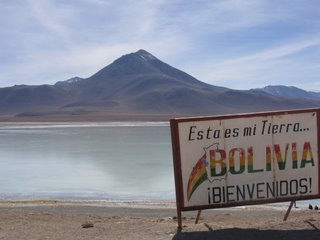
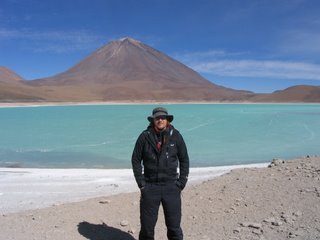
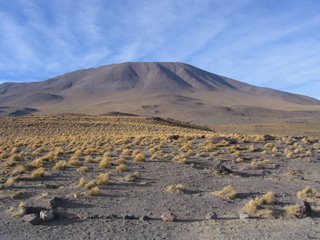
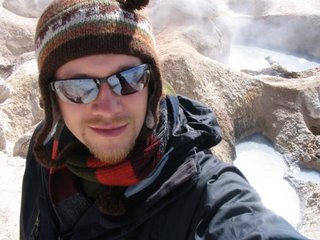
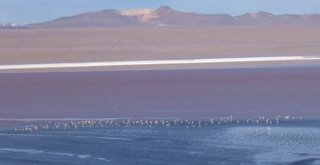
It was a bit cold over there in the height of the mountains as well, but not to scare Johanna (my girlfriend coming to Chile very soon, finally) too much, they told me it does not get colder than this (-15 Celsius) in the south of Chile..
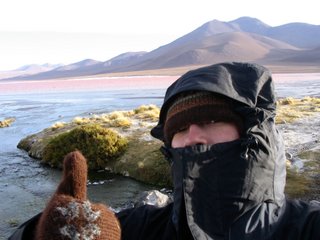
The first overnight reminded me again of my military service. Our room was some 10 below zero and the rented sleeping bags were made for – you guessed it- midgets. So not too much sleep there, but the journey continued in the jeep to the
Arbol de Piedra (or, Stone Tree) below.
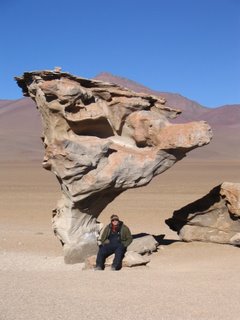
After that we had a long run of dying villages and generally boring sights (except the lake below) before entering a hotel that was total luxury after the first night. If you are wondering how someone would pay for such shit, I can tell you that lodging, travel, food etc. were all included for the three days on the 65 USD price. And just one night's lodging was feeble, otherwise we were really taken care of in the tour.
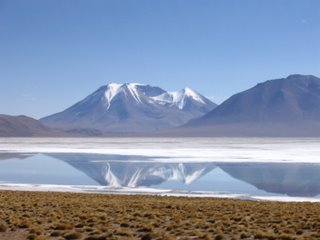
The last day we headed for a sunrise on a cactus-filled island, Isla de Pescadores. Here is also our team of 7: Shane and Suzie from Ireland, Marco from Canada, our driver Lucas (a pro driver who had a glass eye and thus wore sunglasses even in the night!!!) and Gunther from Germany in the upper row and me and Gunther’s wife Inga in the front.
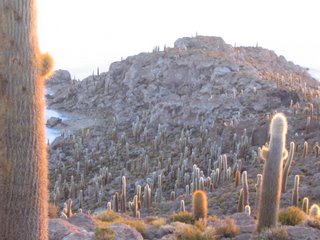

Last I present to you a typical view of the Salar of Uyuni, a huge salt plain (12,000 square kliometers, at places over 1 meter of salt... the water in the ground trying to get out makes those hexagons) followed by a picture of me on a very old locomotive in the cemetery of trains close to Uyuni. The translated text says “
asi es la vida” = “such is life” and on smaller text in the front: “
se necesita un mecanico con experiencia –urgente!” = “in need of a experienced mechanic –urgent!”



























































